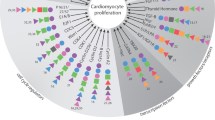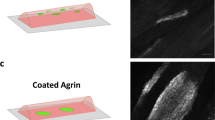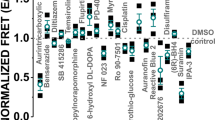Abstract
This protocol describes detailed procedures for the fluorescent high-throughput screening of small molecules that induce neurogenesis in cultures of skeletal muscle cells. The detection of neurogenesis relies on a fluorescent dye, FM 1-43, which is used to study the neuronal property of depolarization-induced synaptic vesicle recycling. Thus, small molecules with neurogenesis-inducing activity in skeletal muscle cells can be rapidly identified by measuring the fluorescence intensity of the treated cells using a fluorescent microplate reader. This protocol uses murine myoblast C2C12 cells for screening, which are readily available and relatively easy to culture. Neurogenesis of PC12 cells induced by nerve growth factor is employed as a positive control for this screening. The screening time for this protocol is 8 d, which also includes the procedure to detect depolarization-induced synaptic vesicle recycling using FM 1-43.
This is a preview of subscription content, access via your institution
Access options
Subscribe to this journal
Receive 12 print issues and online access
$259.00 per year
only $21.58 per issue
Buy this article
- Purchase on Springer Link
- Instant access to full article PDF
Prices may be subject to local taxes which are calculated during checkout




Similar content being viewed by others
References
Kim, J.H. et al. Dopamine neurons derived from embryonic stem cells function in an animal model of Parkinson's disease. Nature 418, 50–56 (2002).
Reubinoff, B.E. et al. Neural progenitors from human embryonic stem cells. Nat. Biotechnol. 19, 1134–1140 (2001).
Swijnenburg, R.J. et al. Embryonic stem cell immunogenicity increases upon differentiation after transplantation into ischemic myocardium. Circulation 112 (9 suppl.), I166–I172 (2005).
Gray, J.A. et al. Conditionally immortalized, multipotential and multifunctional neural stem cell lines as an approach to clinical transplantation. Cell Transplant. 9, 153–168 (2000).
Clarke, D. & Frisén, J. Differentiation potential of adult stem cells. Curr. Opin. Genet. Dev. 11, 575–580 (2001).
Pessina, A. & Gribaldo, L. The key role of adult stem cells: therapeutic perspectives. Curr. Med. Res. Opin. 22, 2287–2300 (2006).
Williams, D.R. et al. Synthetic small molecules that induce neurogenesis in skeletal muscle. J. Am. Chem. Soc. 129, 9258–9259 (2007).
Betz, W.J. & Bewick, G.S. Optical analysis of synaptic vesicle recycling at the frog neuromuscular junction. Science 255, 200–203 (1992).
Murthy, V.N. & Stevens, C.F. Synaptic vesicles retain their identity through the endocytic cycle. Nature 392, 497–501 (1998).
Watanabe, Y. et al. Conversion of myoblasts to physiologically active neuronal phenotype. Genes Dev. 18, 889–900 (2004).
Gaffield, M.A. & Betz, W.J. Imaging synaptic vesicle exocytosis and endocytosis with FM dyes. Nat. Protoc. 1, 2916–2921 (2006).
Yaffe, D. & Saxel, O. Serial passing and differentiation of myogenic cells isolated from dystrophic mouse muscle. Nature 270, 725–727 (1977).
Katagiri, T. et al. Bone morphogenetic protein-2 converts the differentiation pathway of C2C12 myoblasts into the osteoblast lineage. J. Cell Biol. 127, 1755–1766 (1994).
Chen, S., Zhang, Q., Wu, X., Schultz, P.G. & Ding, S. Dedifferentiation of lineage-committed cells by a small molecule. J. Am. Chem. Soc. 126, 410–411 (2004).
Dichter, M.A., Tischler, A.S. & Greene, L.A. Nerve growth factor-induced increase in electrical excitability and acetylcholine sensitivity of a rat pheochromocytoma cell line. Nature 268, 501–504 (1977).
Zhou, T. et al. Neurons derived from PC12 cells have the potential to develop synapses with primary neurons from rat cortex. Acta Neurobiol. Exp. (Wars) 66, 105–112 (2006).
Bonavaud, S. et al. Preparation of isolated human muscle fibers: a technical report. In Vitro Cell. Dev. Biol. Anim. 38, 66–72 (2002).
Klein, M. & Kandel, E.R. Presynaptic modulation of voltage-dependent Ca2+ current: mechanism for behavioral sensitization in Aplysia califonica. Proc. Natl. Acad. Sci. USA 75, 3512–3516 (1978).
Roy, N.S. et al. In vitro neurogenesis by progenitor cells isolated from the adult human hippocampus. Nat. Med. 6, 271–277 (2000).
Acknowledgements
This work was supported by a grant of the NRL program (MOST/KOSEF). G.-H.K. thanks the BK 21 program (KRF).
Author information
Authors and Affiliations
Corresponding author
Rights and permissions
About this article
Cite this article
Williams, D., Kim, GH., Lee, MR. et al. Fluorescent high-throughput screening of chemical inducers of neuronal differentiation in skeletal muscle cells. Nat Protoc 3, 835–839 (2008). https://doi.org/10.1038/nprot.2008.47
Published:
Issue Date:
DOI: https://doi.org/10.1038/nprot.2008.47
Comments
By submitting a comment you agree to abide by our Terms and Community Guidelines. If you find something abusive or that does not comply with our terms or guidelines please flag it as inappropriate.



